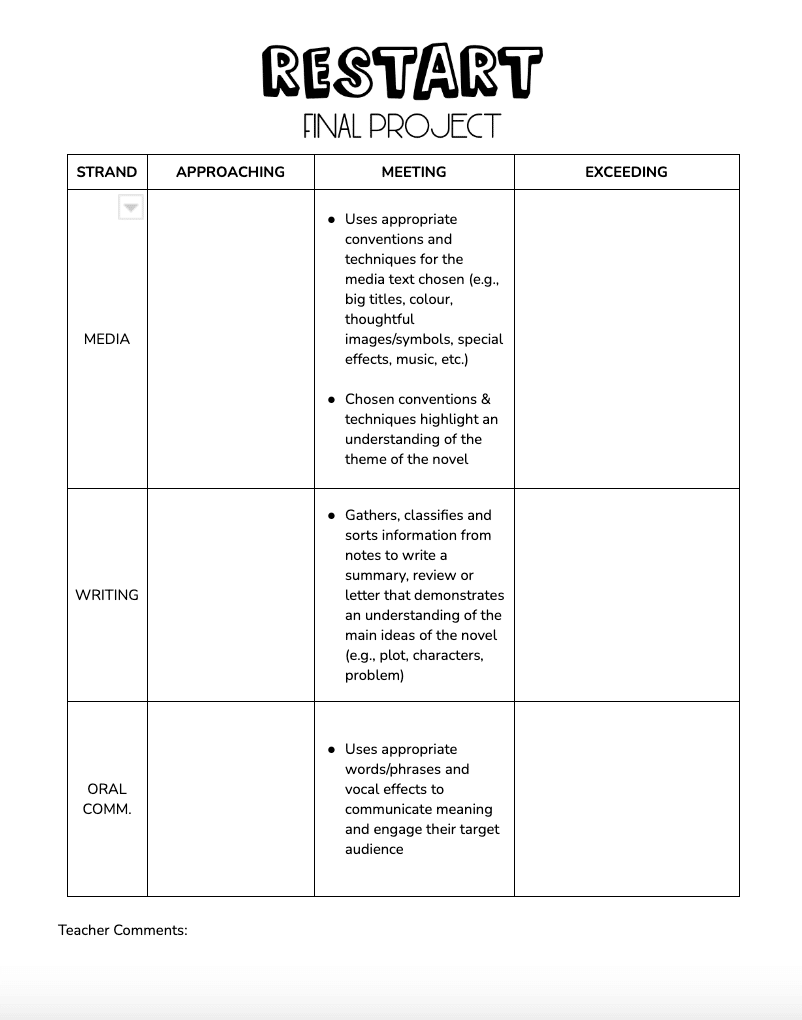Reading comprehension, spelling, fluency, grammar, writing structure… oh my 🫠. No wonder ELA teachers are always stressed out, right? Grading in Language can be super overwhelming, especially because we often feel the need to grade *everything* to get an accurate representation of a student. But I’m here to be your saving grace and tell you that is just not true. This blog post will teach you how to set yourself up for success so that you can save time grading and spend more time doing what you love.

Step 1: Get Clear on the Grades You Actually Need
We often spend a lot of time on long, formal assessments because they feel like solid proof for a final grade. Of course, this type of assessment is important but you don’t need to do a ton of it! Reach out to your administrators or teaching partners for a better idea of how many formal assessments are expected for each term and go off that.
Your grades can also include anecdotal notes – what students say and do. Often times, these types of assessments also help our struggling writers show what they know. When I track observations, I love using a digital anecdotal notebook.
Overall, I always aim for 4 grades in each subject/strand per term. Something like a final writing project may even count for two different grades depending on the criteria (e.g., 1 grade in my notes would be for conventions (spelling, grammar, punctuation) and the other would be for their use of creative figurative language and the overall piece.)
For example, my writing grades for this semester are:
- Summary
- Book Review
- Informative Paragraph
- Grammar & Spelling Quizzes
- Observations
Step 2: Use Success Criteria to Help You Save Time Grading
When grading something as large as a writing piece, it can be difficult to not get caught up in the details. That’s why success criteria is so important. When you figure out which expectations you need to focus on, that is all you need to worry about while marking. For example, if the students are writing a summary, you might focus on finding main & supporting ideas and spelling/grammar. This means you don’t need to go in and give them detailed feedback on using better adjectives, because that is not what you are grading and looking for.
Step 3: Have Students Self-Assess
I started a self-assessment strategy this year that I am obsessed with. In short, I give students a single-point rubric and have them assess themselves at the end of the assignment. If they feel they are exceeding, they have to write in the “exceeding” section what they’ve done that is above and beyond the “meeting” expectation in the middle. This has them really reflect on and think about their work. It also shows you exactly where and what to look for to determine if they really are exceeding expectations and should earn a level 4. It also takes the pressure off of you to give high grades if you realize the students don’t even think they deserve it!
Here is an example:

Step 4: Schedule in Grading Time
I am so sorry to tell you this… but we need to talk. If you aren’t intentionally putting time into your planner to grade each week, it will NEVER feel easy. And seriously, it’s time to start using your preps and stop socializing. Don’t get me wrong… I love a good staff room chat, but when it takes time away from my friends and family on the weekend, I regret it.
So, each week I look at my calendar and block off two afternoon preps for grading and ONLY grading. I am productive in the morning but I always feel like I end up finding something else to do to prepare for the day (e.g., photocopies, improve a lesson). But in the afternoon, I can actually focus on grading. If you teach an assessment heavy subject like writing, you may want to schedule one night a week to stay an hour after school as well. If you stick to this schedule, you will have so much less to do at home – I promise.
Step 5: Get in the Zone
Grading can be monotonous. I challenge you to really get in the zone when you are assessing bigger ELA assignments by setting a goal for how long you want each assignment to take (e.g., 5 minutes per student). Set a timer for that on your computer and move your phone away from you. Hit the timer and GO! This feeling of being “down-to-the-wire” usually allows us to work 100 times faster than we would if we didn’t have a time constraint. And trust me, you’ll feel so accomplished when you finish grading a bunch of assignments in a shorter amount of time than you thought possible.
In conclusion, grading in ELA doesn’t have to be overwhelming. By getting clear on what formal grades you actually need, using success criteria, having students self-assess, scheduling in grading time, and getting in the zone, you can make the process more efficient and less time-consuming. Give these strategies a try and save time grading!
If you liked this post you may also love…
Using a Digital Gradebook to Save Time























